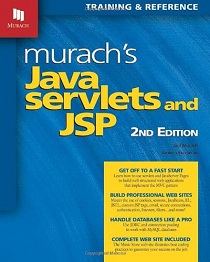Murach’s Java Servlets and JSP, 2nd Edition
eBook Details:
- Paperback: 758 pages
- Publisher: WOW! eBook & Associates; 2nd edition (January 21, 2008)
- Language: English
- ISBN-10: 9781890774448
- ISBN-13: 978-1890774448
eBook Description:
Murach’s Java Servlets and JSP, 2nd Edition
This new edition of Murach’s Java Servlets and JSP makes it easier than ever for Java developers to master web programming. It starts by showing how to install and use Tomcat as a web server and NetBeans as an IDE. Then, it teaches how and when to use JavaServer Pages and Java servlets to build well-structured web applications that implement the MVC pattern. Next, it shows how to use sessions, cookies, JavaBeans, Expression Language (EL), the JSP Standard Tag Library (JSTL), and custom tags. Then, it shows how to use JDBC and connection pooling to work with a MySQL database. Finally, it shows how to use JavaMail, SSL/TLS, authentication, listeners, and filters. These are the skills that you need to build professional Java web applications. A great read for any Java developer.
Ever since we published the first edition of this book back in 2003, we’ve been getting feedback like this from developers:
“This book is excellent, excellent, excellent! The authors have a gift for developing the topic of JSP, Servlets, and building a Java-based ecommerce site in a methodical, easy-to-understand approach.”
Now, I’m delighted to tell you that you’ll feel the same way about this new, 2nd edition. The content has been redone from start to finish, so you’ll learn the best features, tools, and techniques for developing today’s web applications (see what’s NEW below).
But our popular approach hasn’t changed: This 2nd edition still presents Java web programming in a way that’s methodical, easy to understand, and easy to apply to your own web development projects (see what’s the same below).
What you’ll learn in this book
If you look at the table of contents, you’ll see that this book teaches all the skills you need to develop almost any type of Java web application today. The chapters gradually move from the simple to the complex as they show you how to work with:
- the Tomcat servlet/JSP container
- the NetBeans IDE
- HTML pages and forms
- JSPs, servlets, and the MVC pattern
- sessions and cookies
- JavaBeans
- the JSP Expression Language (EL)
- the JSP Standard Tag Library (JSTL)
- custom JSP tags
- MySQL, JDBC, and connection pooling
- JavaMail
- SSL and secure connections
- authentication
- advanced HTTP skills
- listeners
- filters
To complete your training, section 5 presents an e-commerce web site that puts these skills into context. Once you understand how this web site works, you will have all the skills and code you need to start creating your own custom web applications.
What’s NEW in this edition
- You get coverage of all the current software versions: Java SE 6, Java EE 5, servlet 2.5, JSP 2.1, Tomcat 6, NetBeans IDE 6, and MySQL 5.
- Today, some excellent IDEs (integrated development environments) for Java web development are available for free. As a result, it no longer makes sense to use a text editor and a command prompt to develop Java web applications. That’s why this book now shows you how to use one of the most popular open-source Java IDEs, NetBeans. Right from the start, you’ll learn how to use this tool to develop web applications faster than ever.
- You’ll learn how to use the JSP Expression Language (EL) and the JSP Standard Tag Library (JSTL). These features often work together, and they allow you to write code that’s more compact and easier to understand and maintain than you can using standard JSP tags.
- You’ll see how to work with listeners, which were introduced in the servlet 2.3 specification. A listener is a class that listens to web applications for certain events and provides methods that are executed when those events occur.
- Another new servlet feature, filters, can be used to intercept HTTP requests and execute code before or after the requested servlet or JSP is executed. So you’ll also find out how to use filters to enhance your web applications.
What’s the same
- You still get detailed instructions for installing and configuring a Java web development environment on your own PC. Although Tomcat, NetBeans, MySQL, and Java itself are all free, it can be frustrating and time-consuming to get them set up right. So the work-saving advice you get here will pay for the book almost at once.
- You still get full coverage of what you need to know to build business web applications, presented in a way that’s easy to understand.
- You still get the paired-pages format that our customers like so much.
- You still get dozens of coding examples and the code for a full web site so you always see how the features you’re learning are applied in the real world.
Paired-pages format
Like all Murach books, this book present all of its information in “paired pages,” with the essential syntax, guidelines, and examples on the right page and the perspective and extra explanation on the left page.
This helps you learn faster by reading less, and it makes an ideal reference format when you need to refresh your memory about how to do something later on. To see how this works in more detail, please download a sample chapter.
Our Money-Back Guarantee
Like all of our books, this book is backed by our 90-day, money-back guarantee: If you buy this book directly from us and aren’t satisfied with it, you can return it anytime within 90 days and we’ll give you a full refund. No questions asked. So order your copy today!
[download id=”22″ format=”1″]




